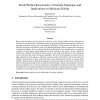Free Online Productivity Tools
i2Speak
i2Symbol
i2OCR
iTex2Img
iWeb2Print
iWeb2Shot
i2Type
iPdf2Split
iPdf2Merge
i2Bopomofo
i2Arabic
i2Style
i2Image
i2PDF
iLatex2Rtf
Sci2ools
CN
2006
2006
Small-world characteristics of Internet topologies and implications on multicast scaling
Recent work has shown that the physical connectivity of the Internet exhibits small-world behavior. Characterizing such behavior is important not only for generating realistic Internet topology, but also for the proper evaluation of large-scale content delivery techniques. Along this line, this paper tries to explain how the small-world behavior arises in the Internet topologies and how it impacts the performance of multicast techniques. First, we attribute the small-world behavior to two possible causes--namely the variability of vertex degree and the preference for local connections for vertices. We have found that both factors contribute with different relative degrees to the small-world behavior of the autonomous system (AS) level and router level Internet topologies. For the AS level topology, we observe that the high variability of vertex degree is sufficient to cause the small-world behavior, but for the router level topology, the preference for local connectivity plays a more ...
| Added | 11 Dec 2010 |
| Updated | 11 Dec 2010 |
| Type | Journal |
| Year | 2006 |
| Where | CN |
| Authors | Shudong Jin, Azer Bestavros |
Comments (0)

